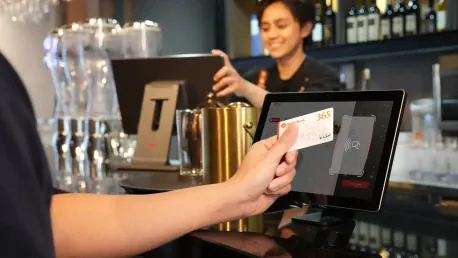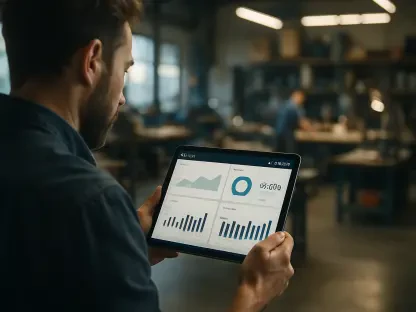The rapid evolution of payment technology over the past decade has been transforming various industries, with the restaurant sector being a significant beneficiary. The transition from cash transactions to seamless digital payment methods is reshaping the landscape of this industry. By 2025, restaurants are expected to fully embrace advanced payment technologies, focusing on eliminating cash and prioritizing digital methods. This shift includes a greater emphasis on contactless payments, digital wallets, embedded payments, AI-powered experiences, and omnichannel payment options. These changes not only provide unparalleled convenience and efficiency for both consumers and businesses but also open up new avenues for personalization and customer engagement.
The Rise of Contactless Payments and Digital Wallets
The shift towards contactless payments and mobile wallets is gaining momentum in the restaurant industry. These methods cater to the need for quicker, more frictionless transactions, especially with the rise of online ordering and food delivery services. Enhanced customer satisfaction and reduced wait times are key benefits of contactless payments. In fast-casual settings, where speed is crucial, these methods streamline the payment process, leading to improved customer experiences.
Mobile payment solutions such as Apple Pay, Google Pay, and other digital wallets are expected to become even more prevalent. This ease of use encourages higher spending and reduces checkout hesitation. As more consumers become comfortable with these technologies, restaurants must adapt to meet their expectations, ensuring a seamless and efficient payment experience. The adoption of contactless payments also emphasizes hygiene and safety, factors that have become increasingly important to both consumers and businesses in recent years.
Contactless payments and digital wallets are not only beneficial for customers but also for restaurants. These methods reduce the handling of cash, thereby minimizing the risk of errors and theft. Additionally, the use of digital wallets allows restaurants to gather valuable customer data, which can be used to tailor marketing efforts and improve service offerings. The integration of loyalty programs with digital wallets encourages repeat business and provides customers with convenient ways to earn and redeem rewards, creating a win-win situation for both parties.
Fee and Rate Auditing: A Growing Necessity
The surge in digital ordering and card-not-present transactions has led to higher processing rates for many restaurants and quick service restaurants (QSRs). The focus has shifted to reducing the costs associated with these transactions. Consulting firms and tools like Staitment are being leveraged to identify and mitigate unnecessary fees. Regular audits of merchant fees and monthly statements are crucial for maintaining profitability. As restaurants adapt to digital payment methods, closely monitoring and optimizing payment processing fees become essential to staying competitive.
By identifying hidden fees and negotiating better rates, restaurants can significantly reduce their operational costs, ensuring a healthier bottom line. Frequent fee audits and the implementation of advanced analytical tools allow businesses to better understand their payment processing expenses. This understanding helps in making informed decisions regarding payment service providers, ultimately leading to cost savings.
Consulting firms and specialized tools play a crucial role in helping restaurants navigate the complexities of payment processing. These resources can uncover hidden fees and provide strategies to minimize costs. By continuously monitoring and optimizing payment processing fees, restaurants can enhance their profitability while ensuring they remain competitive in a rapidly evolving market. The proactive management of payment costs is essential, especially as the industry moves towards greater reliance on digital payment methods.
Embedded Payments: Enhancing the Dining Experience
Embedded payment systems are becoming pivotal in enhancing the restaurant experience. These systems allow customers to pay directly through various platforms, such as the restaurant’s website, app, QR codes, self-service kiosks, or smart tables. The elimination of manual card swipes or signatures reduces transaction times, leading to faster table turnover and increased efficiency.
Embedded payments also support customer loyalty programs, which are expected to grow in popularity. Personalized upsells during the payment process, driven by AI, can further drive sales and enhance the guest experience. By integrating these systems, restaurants can offer a more streamlined and engaging payment process, ultimately boosting customer satisfaction and loyalty. The seamless nature of embedded payments also promotes a hassle-free dining experience, encouraging repeat visits and positive word-of-mouth.
The integration of embedded payments not only simplifies transactions but also opens up new opportunities for restaurants to enhance their service offerings. With embedded payments, restaurants can easily implement personalized promotions and special offers tailored to individual customer preferences. This level of personalization can improve customer satisfaction and encourage greater spending. Additionally, embedded payments can provide valuable data on customer behavior and preferences, helping restaurants refine their marketing and service strategies.
AI and Predictive Payments: The Future of Personalization
AI-powered personalization is a key trend in restaurant payment technology. By leveraging past behavior, preferences, and loyalty data, restaurants can offer tailored payment options, enhancing operational efficiency and boosting customer retention. AI-driven solutions can automate simple tasks, reducing human error and cutting costs. Predictive capabilities may extend to suggesting appropriate tips based on service quality and previous behaviors, leading to more consistent gratuity and higher satisfaction for both customers and employees.
The automation of payment processes through AI not only improves efficiency but also provides valuable insights into customer behavior. This data can be used to create personalized marketing strategies, further enhancing the dining experience and driving revenue growth. AI-powered systems can analyze vast amounts of data to identify trends and patterns, enabling restaurants to make data-driven decisions that enhance both customer satisfaction and operational performance.
AI’s role in predictive payments extends beyond personalization, as it can also help automate routine administrative tasks, such as processing payroll or managing inventory. This automation frees up staff to focus on delivering exceptional customer service, ultimately creating a more efficient operation. By leveraging AI and predictive payments, restaurants can stay ahead of the competition, offering a seamless, personalized experience that meets the evolving demands of today’s consumers.
Omnichannel Payments: A Seamless Experience Across Platforms
The expectation of a seamless payment experience across various channels is driving the adoption of omnichannel payment solutions. Restaurants aim to unify multiple ordering platforms to cater to diners who prefer different modes of ordering and payment. The integration of delivery and dine-in payment options will make tracking payments and loyalty programs easier, enhancing the overall customer experience.
These unified systems provide consistent payment options regardless of the dining format. By offering a seamless and integrated payment experience, restaurants can meet the diverse needs of their customers, ensuring a smooth and enjoyable dining experience across all platforms. The ability to effortlessly transition between different payment methods and platforms is becoming increasingly important as consumer expectations continue to evolve.
Omnichannel payment solutions not only enhance the customer experience but also provide restaurants with valuable data on customer behavior across various touchpoints. This data can be used to optimize marketing efforts and improve service offerings. The integration of multiple payment channels also streamlines operations and reduces the complexity of managing different systems. By adopting omnichannel payments, restaurants can stay competitive in a rapidly changing market, providing a consistent and satisfying experience for their customers.
Technological Integration: Meeting Consumer Demands
The overarching theme is the integration of advanced payment technologies within the restaurant industry. This integration is driven by the need to cater to tech-savvy consumers who demand convenience, security, and personalization. Enhancing the customer experience is a central focus. Contactless payments, AI-driven solutions, and embedded payment systems contribute to a smoother, faster, and more personalized dining experience.
Streamlining payment processes through digital methods and AI-driven automation improves operational efficiency. Faster transactions and reduced human error contribute to better overall operations. Advanced payment systems encourage higher spending by reducing checkout hesitation and enabling personalized upsells. Enhanced customer satisfaction also translates to increased revenue. The integration of advanced technologies not only meets consumer demands but also provides a competitive edge in the bustling restaurant industry.
With the continuous advancements in payment technology, restaurants must stay agile and adaptable. Integrating new payment solutions requires a thoughtful approach, taking into account the unique needs and preferences of the restaurant’s customer base. By doing so, restaurants can ensure they provide a seamless and enjoyable dining experience that keeps customers coming back. Embracing technological integration is not only about meeting current demands but also about future-proofing the business to remain relevant in an ever-evolving market.
Data-Driven Insights: Optimizing Payment Processes
The rapid progression of payment technology has been revolutionizing multiple industries, with the restaurant sector reaping substantial benefits. The migration from traditional cash transactions to efficient digital payment methods is changing the face of this industry. By 2025, it is anticipated that restaurants will fully adopt advanced payment technologies, moving away from cash and focusing predominantly on digital solutions. This paradigm shift will place a substantial emphasis on contactless payments, digital wallets, integrated payments, AI-driven experiences, and multi-channel payment options. These advancements offer unmatched convenience and streamline operations for consumers and businesses alike. Furthermore, they create new opportunities for personalized services and enhanced customer interactions, boosting engagement and satisfaction. The drive towards digital transformation is not merely a trend for efficiency but also a strategic move to enhance user experience and foster deeper connections with customers.









